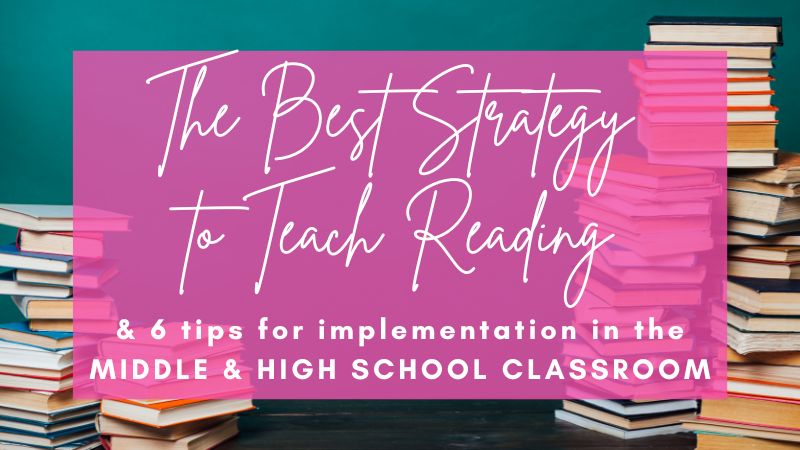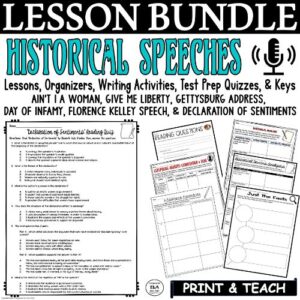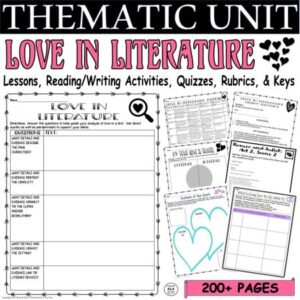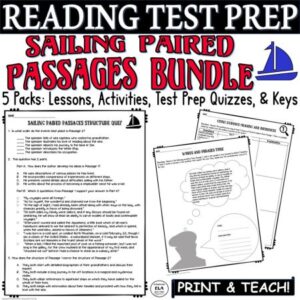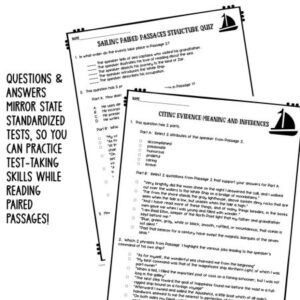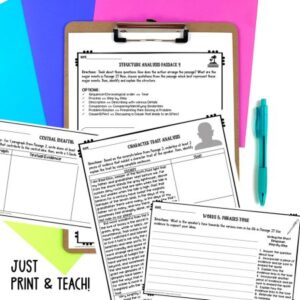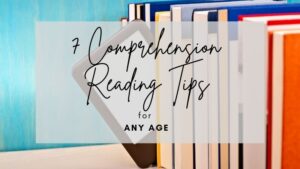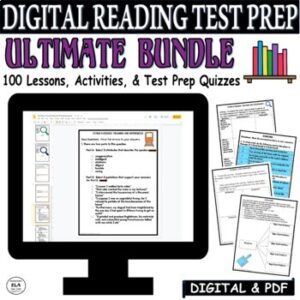I have been an English teacher for over 17 years in the secondary classroom (middle and high school), and I have also had the awesome pleasure and responsibility of teaching my 1st grader how to read. Throughout my years teaching everything from 6th grade English to dual enrollment courses, I have learned a thing or two about how to help students grow in their reading comprehension skills. And my best strategy to teach reading goes against the grain of popular tactics of the last 30 years.
Here is what I was taught in my college classes and throughout my years taking professional development courses:
- There is no real need to teach phonics- Kids will just figure reading out through exposure to sight words and context clues.
- Standardized tests are the devil- It is a necessary evil, and you as well as your students will be judged by them every year.
- Students need tons of scaffolding before accomplishing anything- Everything needs to be explained over and over again before work can begin.
- Reading passages that teachers choose should be at their students’ current reading level- If the text is too high level, students will become frustrated and will not read.
- Give less work, not more- Kids are just not capable of concentrating for long periods of time.
- Don’t grade student writing strictly- Students will become demoralized.
- Teaching grammar skills is a waste of time- Instead, only teach sentence combining.
I am sure there are more “things” I learned, but these are the ones that really stick out. Now, as a seasoned teacher and homeschooling mom, I utterly reject the status quo!
And anyone can easily see that these mantras have most certainly NOT worked to help our students succeed. Let’s go against this grain then and use the BEST strategy to teach reading…
Keep scrolling to check out The BEST Strategy to Teach Reading & 6 Tips for Implementation in the middle and high school English classroom!
Need help with Reading Comprehension Testing? Check out this FREE Pack of 3 Test Prep Activities to help students achieve success on standardized tests!

The BEST Strategy to Teach Reading
Use MORE, not less, challenging reading passages.
As you choose reading passages, don’t base your choices on your most struggling readers. Consider your higher-level students, not your most struggling students when it comes to selecting what you will DIRECTLY teach!
For example, I was the English teacher in a Math, Science, and Engineering Magnet Program for around 5 years in downtown Jacksonville, FL. Every student who applied was pretty much accepted into this program. Even if a student read below level or had not passed the Algebra state test, he/she was given mostly honors and AP classes.
And more than half of my 9th graders did not pass the state reading standardized test in 8th grade. You might be thinking: “Why were students admitted to a magnet program when they struggled with reading and math?”
Well, my principal at the time believed in access for ANY student. Her mindset is what helped me develop my own BEST strategy to teach reading!
I started out with my first cohort as their 9th-grade English Honors teacher. By the time they reached 11th grade, those same students would have to take AP English Language and Composition. How can a student who is unable to read at the 9th-grade level prepare in 2 years for an AP course? (Remember, AP courses are just as rigorous if not MORE rigorous than freshman college English classes.)
This question is tough to answer, so I challenged the typical curriculum we were given. Even with half of my students below grade level, we read and read and read higher-level literature as the most effective strategy to teach reading.
And guess what? The students who read at or above grade level grew extraordinarily and those below grade level progressed more than the average in our state (even surpassing the growth of the students in our early college program).
Because I LOVED this group of students, I followed them into 10th grade and 11th grade as well.
These are some of the texts we read in their 9th and 10th grade years as I taught with this strategy to teach reading in mind:
FICTION-
- Romeo and Juliet–play
- Julius Caesar–play
- To Kill a Mockingbird-book
- Anthem-book
- The Odyssey-book
- Oedipus Rex-play
- Antigone-play
- The Chocolate War-book
- A Raisin in the Sun-book
- Of Mice and Men-book
- “The Most Dangerous Game”-short story
- “The Necklace”-short story
- “The Gift of the Magi”-short story
- “The Story of an Hour”–short story
- “The Masque of the Red Death”-short story
- “The Vendetta”-short story
- “The Cask of Amontillado”-short story
- “The Monkey’s Paw”-short story
- “Lamb to the Slaughter”-short story
- “The Tell-Tale Heart”-short story
- Whitman’s “I Hear America Singing”-poem
- Wordsworth’s “I Wandered Lonely as a Cloud”-poem
- Dickinson’s “Because I Could not Stop for Death”-poem
- Frost’s “Fire and Ice”-poem
- Poe’s “Annabel Lee”-poem
- Blake’s “A Poison Tree”-poem
- Tennyson’s “The Charge of the Light Brigade”-poem
NONFICTION-
- Jonathan Edwards’ “Sinners in the Hands of an Angry God”
- Jonathan Swift’s “A Modest Proposal”
- Patrick Henry’s “Give Me Liberty” Speech
- FDR’s “Infamy” Speech
- Abraham Lincoln’s “Gettysburg Address”
- Elizabeth Cady Stanton’s “Declaration of Sentiments”
- Sojourner Truth’s “Ain’t I a Woman?”
- Thomas Jefferson’s Declaration of Independence
- “Sending Grandma to the Ovens” Satire
Click below to purchase this ready-made BUNDLE for teaching historical speeches as you implement the best strategy to teach reading!
6 Tips for Implementing This BEST Strategy to Teach Reading
1. Teach Thematically, Topically, and/or Chronologically-
When texts are grouped Thematically, Topically, or Chronologically, students make connections more readily, and this is particularly true as you integrate the best strategy to teach reading!
Too often, we teach by the seat of our pants. And this situation is all too true for newer teachers or if teachers are moved to different grade levels. Well, let’s create a 3-week, 6-week, or 9-week plan to help keep our heads above water.
For example, if you are teaching Romeo and Juliet, let’s plan out this 9-week unit with a focus on Love in Literature!
You could include the following texts as you consider this strategy to teach reading:
- “To My Dear and Loving Husband”-poem
- “Annabel Lee”-poem
- Ezra Meeker’s “Leaving the Home Nest for Iowa”-nonfiction text
- “The Gift of the Magi”-short story
- Romeo and Juliet-play
9 Week Outline- Focus on plot, characterization, and theme!
- Week 1-Introduce Love in Literature Prompts, so students can start preparing for their Literary Analysis Essays; teach “To My Dear and Loving Husband” and “Annabel Lee.”
- Week 2-Teach Ezra Meeker’s “Leaving the Home Nest for Iowa” & “The Gift of the Magi.”
- Week 3- Read/Watch “The Prologue” and Act 1 Scenes 1-2 (focus on the fight in Scene 1)
- Week 4- Read/Watch Act 1 Scenes 3-5 (focus on Scene 5; the party)
- Week 5- Read/Watch Act 2 (focus on Scene 2 and Scene 3; balcony and Friar)
- Week 6- Read/Watch Act 3 (focus on Scene 1 and Scene 3; after marriage and fights)
- Week 7- Read/Watch Act 4 (focus on Juliet’s “death” and scene with Apothecary)
- Week 8- Read/Watch Act 5 (deaths and epilogue)
- Week 9- Essay Writing Week
Check out the bundle below for help with implementing the best strategy to teach reading thematically!
2. Dig deeply into Vocabulary & Background Knowledge-
When we are using more challenging, higher-level texts, we need to scaffold a bit more by focusing on background information and vocabulary as a part of this strategy to teach reading.
Let’s say you want to examine Patrick Henry’s “Give Me Liberty or Give Me Death.” This excerpt is what your students will first encounter:
MR. PRESIDENT: No man thinks more highly than I do of the patriotism, as well as abilities, of the very worthy gentlemen who have just addressed the House. But different men often see the same subject in different lights; and, therefore, I hope it will not be thought disrespectful to those gentlemen if, entertaining as I do, opinions of a character very opposite to theirs, I shall speak forth my sentiments freely, and without reserve.
And if your students are anything like mine, they will need a bit of prep work before they will be able to understand this excerpt.
You may first want to focus on the following vocabulary:
- patriotism
- addressed
- sentiments
- reserve
- House
Additionally, you may choose to view a short historical video regarding the American Revolution to offer vital background information. If students know the purpose of the passage, the speaker, and the audience, reading the entire text will make the comprehension process MUCH easier! This process helps as you integrate this strategy to teach reading!
The same can be said for Sojourner Truth’s speech “Ain’t I a Woman?” Knowing about the time period, the speaker, the audience, and the overall purpose will greatly help as students read and subsequently analyze the passage.
Spending 10-20 minutes BEFORE reading the entire passage will yield HUGE results and more student buy-in as you integrate this vital strategy to teach reading!
3. Read/Reread Excerpts instead of WHOLE texts-
I totally get it; time flies by in a classroom. There is so much to do and so little time to accomplish all of the goals!
When we want our students to make progress though, they need to be challenged with higher-level literature (best strategy to teach reading). So instead of choosing another text, use the literature we know will help our students to grow (a.k.a. best strategy to teach reading)!
And remember, you don’t HAVE to read whole novels over 9 weeks or entire passages in a single class period. If you are teaching early American literature, don’t be tempted to skip “Sinners in the Hands of an Angry God” or the Declaration of Independence. They are difficult texts for many college students to comprehend, but students don’t have to understand EVERY single part.
Gosh, if I had to comprehend every last word, phrase, sentence, scene, etc. of a piece of literature, I would never get through any book. Sometimes, I get distracted or I may learn a word along the way or I get to the end and it clicks. The same thing happens for our students.
If you want to emphasize certain parts of a passage, reread that part only as you integrate the best strategy to teach reading. It’s totally okay! That’s what makes it a good strategy to teach reading!
Want to read more about another strategy to teach reading? CLICK BELOW!
4. Discuss the Reading-
Too often, our students read something and move on to a comprehension and/or analysis activity. But more than anything, we need to give our students time to process their own thoughts, sit still with the text for a while, and just talk with others about what they have just read.
You can accomplish this goal in several ways, but my favorite is utilizing a Socratic Seminar with rotating groups as a part of implementing the best strategy to teach reading.
- Let students skim/reread the text.
- Highlight and/or underline the parts that seem the most relevant to meaning, purpose, etc.
- Provide question stems for students to use, so they can create their questions based on certain parts of the passage.
- Participate in groups that first discuss the passage together. Let students sit with each other in groups of 4-6 around the classroom and ask questions of each other.
- After 5-10 minutes of practicing their discussion skills, encourage 1 student from each group to participate in a seminar in front of the entire class.
- Students can rotate in and out every 5 or so minutes. If students are shy or quieter, they can participate by asking a question, answering a question, or commenting on what another person has said.
- During the seminar, let students fill out Shout-Outs for each other; they can write down a student’s name and what that other student did well.
- Share out and reflect at the end of the seminar; give students time to provide this positive feedback to other students!
5. Listen to the Audio Version while Reading Along in Print-
When I was a kid, I read all of the time, but I also loved being read to. There is nothing wrong with including audiobooks in your classroom; in fact, your students might enjoy the listening/reading process a bit more with a professionally read passage. Plus, it gives your voice a break as you implement this strategy to teach reading!
One of my favorite moments of listening to the radio occurred on July 4th. I was following along to a certain station, and it started playing the Declaration of Independence. Even though I had attended a conservative high school, graduated from college, and earned my master’s degree, I had never read this seminal document that helped shape our country. This experience of hearing this text was so powerful, and the entire reading was completed in 10-15 minutes.
Super simple, but super effective!
6. Create Opportunities to Respond in Writing-
After reading, one of the BEST things students can do is respond in writing. When we write, we remember. Listening is wonderful as a stepping stone to the comprehension process, but there is just something about writing that makes us think more deeply and connect with what we have read!
You have lots of options that DON’T HAVE to be an essay:
- 1-Sentence Summaries– Students can write a 1-Sentence Summary for a paragraph, chunk, excerpt, page, or even the whole text!
- Paragraph Response- Students can respond to what they have read through focused questions on characterization, theme, tone, mood, etc.
- Journal Entry- Students can respond in the voice of the writer or reflect on what they have read in a free-write.
- Advertisement- Students can write an ad promoting the attributes of the text.
- Questioning the Text- Students can create questions based on certain pieces of relevant textual evidence.
Why should you implement this strategy to teach reading as soon as possible?
- When we can help students through a piece of higher-level literature, the confidence to read ANY text will increase!
- They can apply newly learned vocabulary and knowledge in other classes.
- Using at-level texts will not really help your students who read on or above level.
- Your students will be more prepared for college and the workforce.
- Your classes will truly understand that you are NOT underestimating them!
Ultimately, I know my stance concerning this strategy to teach reading is a bit controversial. But I know what I know.
I have seen my level 1 readers soar to levels 4 or 5! I have seen students who did not pass the state reading test pass the AP Lang test. I have seen my own daughter read at a 4th-5th grade level at the start of 1st grade.
What is uncomfortable makes us grow, even if it “hurts” or strains us at times. This is why need to read WITH our students when we can as a part of the BEST strategy to teach reading!

